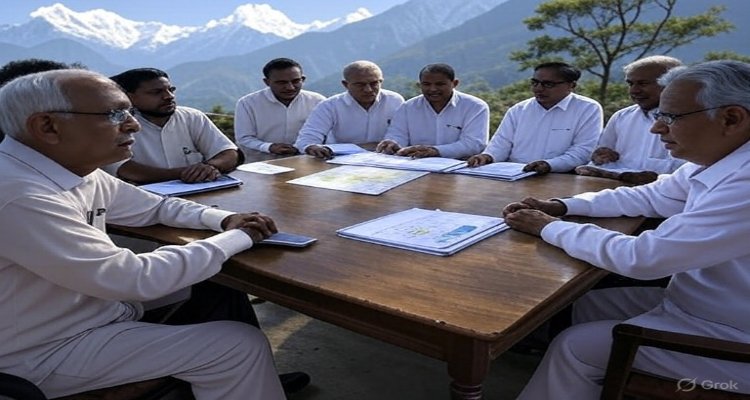Unlocking Rural Progress: The Untied and Tied Formula of India’s Finance Commission Grants
Untied and tied grants from the Finance Commission are two distinct funding mechanisms that play a crucial role in strengthening grassroots governance in India. Untied grants provide flexibility for local bodies to address priority needs, while tied grants focus on national objectives like clean water and sanitation. Understanding the difference is essential for appreciating how rural governance and development are funded in India.
Introduction
When the Union government disburses funds to rural India, the impact goes beyond numbers—it shapes how local bodies respond to people’s needs. The recent release of untied grants to states like Odisha, Tripura, and Mizoram as part of the 15th Finance Commission (XV FC) shines a spotlight on the vital mechanisms—untied and tied grants—that fuel local progress, autonomy, and accountability.manoramayearbook+1
Context & Background
The 15th Finance Commission was constituted in 2017 against a backdrop of major policy changes, including the dissolution of the Planning Commission and the advent of the Goods and Services Tax (GST). These reforms redefined India’s federal fiscal relations, demanding a fresh approach to how funds travel from the Centre to the states and ultimately reach rural and urban local bodies.manoramayearbook
Covering the period from 2021–26, the 15th Finance Commission, chaired by N.K. Singh, recommended grants totaling ₹4,36,361 crore for local governments. Its design replaced the outmoded plan/non-plan expenditure split and prioritized a transparent, formula-driven system based on population and area.prsindia+1
Main Developments
Grant Allocations in Focus
In the financial year 2025–26, significant allocations have been made:
-
Odisha: ₹240.81 crore for 6,085 Gram Panchayats and 63 Block Panchayats
-
Tripura: ₹29.75 crore for 606 Gram Panchayats, 35 Block Panchayats, 8 Zilla Parishads, 587 Village Committees, and 40 Block Advisory Committees
-
Mizoram: ₹14.27 crore for 827 Village Councilsmanoramayearbook
Structure of the Grants
The XV FC grants to Panchayati Raj Institutions (PRIs) and Rural Local Bodies (RLBs) have two primary components:
-
Untied (Basic) Grants: Constitute 40% of the grants. These are flexible funds used for needs under the 29 subjects listed in the Eleventh Schedule of the Constitution—ranging from roads, health, and education to local environmental management. They cannot be spent on salaries or administrative costs.prd.wb+2
-
Tied Grants: Form 60% of the total grants. These must be spent on specified national priorities—primarily drinking water, sanitation, open defecation free (ODF) status, water management (including rainwater harvesting and recycling), and household waste management.epanchayat.telangana+1
Release and Utilization
Grants are released in two instalments annually after states meet mandatory conditions. They reach all three tiers: Gram Panchayats, Block/Mandal Panchayats, and Zilla Parishads. The grants are designed to empower PRIs to deliver essential services, enhance accountability, and promote self-reliance.epanchayat.telangana+1
Expert Insight and Public Reaction
Financial analysts and governance experts underline that untied grants are a game-changer for rural India. According to experts, “Untied grants allow local leaders to address pressing community challenges—be it fixing a local road or setting up a digital network—without cumbersome central diktats.” Conversely, tied grants keep local priorities aligned with national imperatives, crucial for maintaining India’s success in areas like sanitation and clean water.prd.wb+1
State officials have welcomed the grants, citing improved capacity for grassroots problem-solving and infrastructure upgrades. However, governance watchdogs caution that misuse of funds must be curtailed through regular audits, tracking, and transparency measures.fincomindia
Impact & Implications
Empowering Local Governments
By giving PRIs control over a significant part of untied funds, the XV FC strengthens local democracy and promotes contextual, need-based development. Local bodies are better positioned to plan and execute projects most relevant to their populations.manoramayearbook+1
Addressing National Priorities
Tied grants ensure that even as PRIs enjoy greater flexibility, critical goals like universal access to clean water and sanitation are not sidelined. This dual strategy advances both local autonomy and national development agendas.epanchayat.telangana+1
Oversight and Challenges
Transparency, regular audits by the Comptroller and Auditor General (CAG), and public reporting have been recommended to ensure that both tied and untied grants are used for their intended purposes. State-level High-Level Monitoring Committees (HLMC) also oversee implementation.fincomindia
Conclusion
The 15th Finance Commission’s two-pronged approach—through untied and tied grants—marks a significant evolution in India’s fiscal federalism. While untied grants respect and enhance local autonomy, tied grants ensure alignment with national objectives. As India moves towards the 16th Finance Commission era, the challenge will be to deepen transparency and innovation in the use of these funds, empowering rural India while safeguarding the collective national interest.
Disclaimer : This article is for informational purposes only and is not intended as financial or policy advice. Readers are advised to consult official government sources for the most accurate and up-to-date information.











